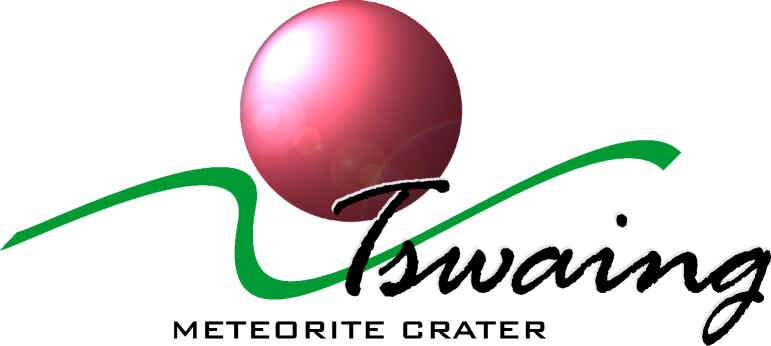|
Pollen grain of the Podocarpus (yellowwood) tree (courtesy Louis Scott, University of the Free State) |
 |
|
Palaeoclimatic Record |
|
|
The Tswaing crater is unique in southern Africa for several reasons. Its relatively young age and well-preserved landscape places it amongst the few excellent examples of impact structures in the world. The palaeoclimatic record is, however, of equal if not greater significance, as it seems unlikely that other terrestrial records of similar length and continuity exist in the region. The lacustrine sediments that filled the crater were deposited in a number of successive fresh and saline lake environments, in which lived numerous diatoms, and around whose borders flourished different types of vegetation. The microfossils within the sediments, diatoms, algae and pollen of fossil plants, not only preserve a history of the life in and around the lake, but their study can also tell us about the changes in climate that have occurred in the region during the past 200 000 years. Tswaing has had an essentially closed crater lake for some 200 000 years, and fluctuations in the chemical composition of the crater lake water and the nature of the material precipitated from the lake would have occurred in response to changes in climatic conditions. The age of the lower sediments is not yet clear, but must postdate the cratering event. The upper 20 metres contain some plant debris, as well as dead algae. This material contains carbon-bearing organic matter, which can be used for radiocarbon dating. The results showed that the upper 20 metres of crater sediments accumulated during the last 40 000 years. Assuming that the rate of accumulation of sediment remained the same for the whole period since the formation of the crater, these results can be interpreted to bracket the age of the lower part of the crater sediments between 40 000 and 180 000 before present. The crater sediments are a rich source of palaeoenvironmental information. Today, the vegetation surrounding the crater consists of Sourish-Mixed Bushveld (savannah), while the climate is subtropical and dry sub-humid. However, this has not always been the case. The nature of the crater sediments provides a record of the palaeoenvironmental changes that have occurred over the past 200 000 years, and particularly over the last 40 000 years. A study of pollens and spores from the drill core has shown that past environments at Tswaing have been both more arid and wetter than today, as indicated by the occurrence of yellowwood paly-species, which are indicative of cooler periods. As part of the analysis of the drillcore, an analysis of the diatoms preserved in the core was undertaken. Diatoms are present in most parts of the core and record both the long-term evaporative concentration of the lake and shorter term climatic variations. The diatoms record a general increase in alkalinity and salinity through time, which is also shown by changes in the minerals contained in the drillcore. The Tswaing core provides the only long-duration diatom sequence for this time span in southern Africa and thus forms a useful record of palaeontological and palaeoenvironmental changes in the region. Pollen, spores and other organic inclusions in the sediments shed light upon the 220 000-year old history of vegetation in the region. Despite gaps in the pollens sequence, the largest of which is between 79 000 and 159 000 years ago, the productive zones of 45% of the drillcore provide new insights on the long-term pattern of climate and vegetation change in the interior of South Africa. The Holocene section, covering the period between 100 000 years and 82 000 years ago, shows that the vegetation in the surroundings of the lake changed from dry bushveld to broad-leaved savannah. Between 33 000 and about 80 000 years ago, generally cool but changing climatic conditions occurred with upland fynbos vegetation and yellowwood forest elements. At least three warmer pulses of varying intensity are recorded at about 38 000-44 000, 60 000 and 62 000, and 75 000 and 79 000 years ago, which resulted in more woody savannah elements in the vegetation. The deepest section ranging in age between 160 000 and 200 000 years ago provides a detailed chronology of Middle Pleistocene environments in the region and suggests two cool phases with grassland, fynbos and yellowwood forest alternating with two relatively warm phases, characterised by dry open grassland savannah. The oldest of these are at the base of the sedimentary sequence and suggest an environment comparable to current dry Kalahari thornveld. |
|
| (Sources: 1. REIMOLD, W U, BRANDT, D, DE JONG, R C, HANCOX, J, 1999, Tswaing Meteorite Crater. An introduction to the natural and cultural history of the Tswaing region including a description of the hiking trail. Popular Geoscience Series 1. Pretoria: Council for Geoscience. Available at the Council for Geoscience, Pretoria, South Africa. 2. PARTRIDGE, T C et al, 1999, Investigations into the origin, age and palaeoenvironments of the Pretoria Saltpan. Memoir No 85 of the Council for Geoscience. Pretoria: Council for Geoscience. Available at the Council for Geoscience, Pretoria, South Africa) | |
| All intellectual property rights, including but not limited to copyright and trademarks, vested in the material contained on the NFI website is held by the NFI and may not be copied, reproduced, adapted, published or distributed in any form whatsoever without the prior written consent of the responsible person at the NFI. | |
